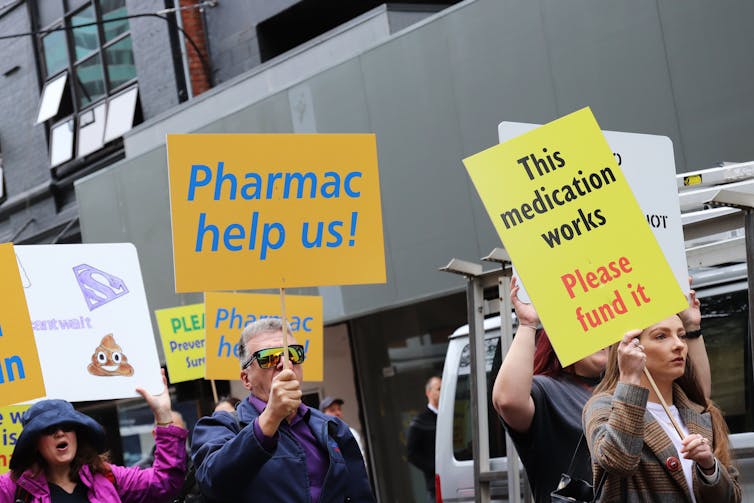Source: The Conversation (Au and NZ) – By Paula Lorgelly, Professor of Health Economics, University of Auckland, Waipapa Taumata Rau
This week the coalition government made a significant investment in Pharmac, increasing funding by NZ$604 million over the next four years.
In doing so, it delivered on a National Party election promise to fund 13 cancer drugs. Specifically, it will fund seven of those named during the election, while the remaining six will be replaced with “as good as or better alternatives”. In total, this will fund up to 54 new drugs, including 26 cancer drugs.
This announcement finally delivers hope to many cancer patients, profits to the pharmaceutical industry, and a sigh of relief for MPs who had been accused of breaking an election promise.
It also reinforces the integrity of the Pharmac process, but it won’t change the fact that access to medicines in New Zealand lags behind other similar countries.
How does the Pharmac process work?
Pharmac is an independent agency that makes decisions about whether pharmaceuticals, vaccines and medical devices deliver value to the New Zealand taxpayer. But these value decisions have to be made within the budget Pharmac is allocated each year.
Pharmac was one of the first health technology assessment agencies. It is internationally held in high regard for the low prices it can negotiate, in part because it manages its own budget.
If Pharmac thinks a drug or device is cost-effective but can’t currently afford it, it puts it on an options for investment list. This is essentially a waiting list that Pharmac will get to if it finds cost savings elsewhere when negotiating prices, or gets more government funding (as has just happened).
The drugs and devices on this list are ranked in order of priority using Pharmac’s factors for consideration. This process is confidential to ensure Pharmac can negotiate the best prices, because if a pharmaceutical company knew it was high on the list, it wouldn’t engage as effectively in price negotiations.

Lynn Grieveson/Newsroom via Getty Images
Benefits beyond cancer patients
Pharmac’s waiting list is heavily criticised. Some drugs, including those it will now fund, were added many years ago.
Among these drugs, for example, Cetuximab for bowel cancer was first submitted to Pharmac in May 2018 and placed on the list in December 2019. An application for Axitinib for kidney cancer was received in September 2013 and ranked in March 2014, and subsequently reranked in 2019, 2021 and 2022.
National had promised to reinstate the $5 prescription charge to pay for its 13 new cancer drugs (which were available in Australia in 2021 but not in New Zealand). That was estimated to bring in $280 million. So why is the government now paying $604 million?
The investment isn’t just paying for these cancer drugs. It would appear Pharmac is holding steadfast that its prioritisation of drugs delivers the most health benefit. My guess is that one of those cancer drugs the government wanted to fund sits at number 54 on the list. To fund it, the investment covers everything listed above it in the options for investment list.
It appears that while the National Party and the Cancer Control Agency Te Aho o Te Kahu said it was important to fund this cancer drug, there were other drugs considered more important and higher priority. Hence cancer patients will benefit but also people with infections, respiratory problems, osteoporosis, sexual health concerns, skin conditions, inflammatory conditions and mental health problems – an estimated 175,000 people in total.
The price of political meddling
Even more patients could benefit if the government had simply promised more money with no strings attached. During the election, Labour promised to increase Pharmac’s funding by $1 billion over four years. National promised an extra $724 million plus ring-fenced cancer drug funding.
Because the National Party chose to name these drugs, the suppliers will be less likely to engage in price negotiations. Providing more money without naming the drugs would have allowed for Pharmac to negotiate better, get a better price and use the latest investment to fund more than 54 drugs.
Despite this uplift in funding, drug availability in New Zealand still lags behind other similar countries. This will likely remain the case because Pharmac can only spend within its budget.
If we wanted greater access to pharmaceuticals, Pharmac would need much more money or we could change the process. Pharmac could simply make decisions and Health New Zealand Te Whatu Ora could fund it.
This is the model used by the UK’s National Health Service (NHS) and National Institute for Health and Care Excellence (NICE). NICE makes decisions that the NHS must fund from its health budget. Essentially, the opportunity cost falls on the wider health and care system.
An alternative to more drug funding
It is possible to improve population health by addressing the social determinants of health (80% of ill health is due to socioeconomic and environmental factors) or by improving access to primary and preventive care, so patients get diagnosed earlier, which is generally cheaper.
The goverment’s decision to repeal New Zealand’s smoke-free legislation and reduce funding for a new, more accessible cervical screening process will cause considerable harms and costs in terms of raising demand for lung and cervical cancer treatments. It is almost as if one coalition agreement giveth and another taketh away.
The discussion of how much funding Pharmac should get and how Pharmac makes decisions (including how long it takes) will continue. An educated guess suggests this latest investment means Aotearoa New Zealand now spends 6.5% of its health budget on pharmaceuticals and less than a third of this will be on oncology.
Isn’t it time to think about the 93% we spend in the rest of the health system and to make that more efficient and equitable?
![]()
Paula Lorgelly consults to Pharmac and has in the past consulted for the pharmaceutical industry. She receives funding from the Ministry of Health and the EuroQol Foundation. Paula is a member of the EuroQol Group which owns the EQ-5D instrument which is widely used in health technology assessments.
– ref. A funding boost for NZ’s drug-buying agency Pharmac to pay for cancer drugs is welcome – but it won’t solve underlying issues – https://theconversation.com/a-funding-boost-for-nzs-drug-buying-agency-pharmac-to-pay-for-cancer-drugs-is-welcome-but-it-wont-solve-underlying-issues-233205









